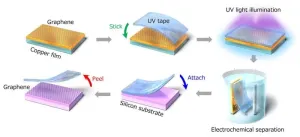(Press-News.org) A technique can determine for the first time how frequently, and exactly where, a molecular event called “backtracking” occurs throughout the genetic material (genome) of any species, a new study shows.
Published online February 9 in Molecular Cell, the study results support the theory that backtracking represents a widespread form of gene regulation, which influences thousands of human genes, including many involved in basic life processes like cell division and development in the womb.
Led by researchers from NYU Grossman School of Medicine, the work revolves around genes, the stretches of DNA molecular “letters” arranged in a certain order (sequence) to encode the blueprints for most organisms. In both humans and bacteria, the first step in a gene’s expression, transcription, proceeds as a protein “machine” called RNA polymerase II ticks down the DNA chain, reading genetic instructions in one direction.
In 1997, Evgeny Nudler, PhD and colleagues published a paper that showed RNA polymerase can sometimes slip backward along the chain it is reading, a phenomenon they named “backtracking.” Studies since then have shown that backtracking occasionally takes place in living cells soon after RNA polymerase begins RNA synthesis or when it encounters damaged DNA to make room for incoming repair enzymes. Subsequent work suggested that the backsliding and repair machinery had to work quickly and dissipate, or it might collide with DNA polymerase to cause cell-death-inducing breaks in DNA chains.
Now a new study led by Nudler’s team at NYU Langone Health reveals that their new technique, Long Range Cleavage sequencing (LORAX-seq), can directly detect where backtracking events begin and end. By complementing past approaches that were indirect or limited, the new method reveals that many such events move backward further than once thought, and in doing so, last longer. The results also suggest that persistent backtracking occurs frequently throughout genomes, happens more often near certain gene types, and has functions well beyond DNA repair.
“The surprising stability of backtracking at longer distances makes it likely that it represents a ubiquitous form of genetic regulation in species from bacteria to humans,” says Nudler, the study’s senior author, and the Julie Wilson Anderson Professor in the Department of Biochemistry and Molecular Pharmacology at NYU Langone. “If further work expands our findings to different developmental programs and pathological conditions, backtracking may be akin to epigenetics, the discovery of which revealed a surprising new layer of gene regulation without changing the DNA code.”
Central to Life?
RNA polymerase II translates DNA code into a related material called RNA, which then directs the building of the proteins. To do so, the complex moves down DNA chains in one direction, but backtracks in certain scenarios. Past studies have shown that as RNA polymerase II backtracks, it forces out (extrudes) from its interior channel the tip of the RNA chain it has been building based on the DNA code. As prolonged backtracking is prone to causing detrimental collisions, transcription is thought to be quickly restored by the transcription factor IIS (TFIIS), which promotes the cutting off (cleavage) of the extruded, “backtracked” RNA. This clears the way for RNA polymerase II to resume its forward code reading.
Other, earlier studies, however, had shown that when polymerase backtracks beyond a certain distance (e.g. 20 nucleobase DNA building blocks), the backtracked RNA can attach to the channel through which it is extruded, holding it in place longer. Locked, backtracked complexes are less likely to be rescued by TFIIS-driven cleavage, and more likely to delay transcription of the gene involved. This led to theory that backtracking, in addition to playing a key role in DNA repair pathways, may dial up or down the action of genes as a major regulatory mechanism.
According to the researchers, TFIIS likely occurs at low concentrations in living cells, and competes with hundreds of other proteins to get at and cut out backtracked RNA so transcription can continue. In the current study, the team instead used a high concentration of purified TFIIS (no competing proteins) to precisely cut out any piece of backtracked RNA anywhere it occurs in a cell’s genetic code. This made the cut-out snippets available to technologies that read code sequences and provide clues to their locations and functions.
The research team also found that the genes that control histones – protein "spools" that DNA chains wrap around within the chromatin that organizes gene expression – are highly prone to persistent backtracking. The authors theorize that the degree to which this happens, with related changes in the transcription of certain genes, may control the timing of large-scale histone accumulation needed during cell division to rebuild chromatin. They also suggest that persistent backtracking may influence the timely transcription of genes vital to tissue development.
“Along with its potentially useful functions, persistent backtracking could also result in DNA damage and other genetic malfunctions that contribute to disease,” says first study author Kevin Yang, a graduate student in Dr. Nudler’s lab. “We speculate that the measurement of backtracking in the context of aging or cancer, for instance, may help us understand why malfunctions occur in the cell stress response and cell replication, and to suggest new treatment approaches.”
Along with Yang and Nudler, study authors from the Department of Biochemistry and Molecular Pharmacology at NYU Langone Health were Aviram Rasouly, Vitaly Epshtein, Criseyda Martinez, Thao Nguyen, and Ilya Shamovsky. Nudler is also an Investigator with the Howard Hughes Medical Institute. The study is funded by the Blavatnik Family Foundation, Howard Hughes Medical Institute, and National Institutes of Health grants R01GM126891 and T32 AI007180.
END
Pioneering technique reveals new layer of human gene regulation
2024-02-09
ELSE PRESS RELEASES FROM THIS DATE:
Reducing diabetes medication costs can help improve outcomes, especially for low-income patients
2024-02-09
BOSTON, MA — A new study led by researchers at the Harvard Pilgrim Health Care Institute has found that reducing out-of-pocket costs for patients with diabetes, especially those considered low income, can be one step toward improving health outcomes.
The study, “Acute Diabetes Complications After Transition to a Value-Based Medication Benefit,” was published in the February 9 edition of JAMA Health Forum.
Treatment with antidiabetic agents, antihypertensives, and lipid-lowering ...
Thermal energy storage and the energy transition: MLU coordinates Europe-wide research project
2024-02-09
An international research project led by the Martin Luther University Halle-Wittenberg (MLU) delves into the next generation of seasonal thermal energy storage systems. The "INTERSTORES" project is investigating optimal ways to construct new types of storage systems and integrate them into energy systems. The collaboration between science and industry will receive nearly eleven million euros as part of "Horizon Europe", with around 1.5 million euros going to MLU. The aim is to improve the ...
An anticancer drug opens a new path for the treatment of Parkinson's
2024-02-09
L'Hospitalet de Llobregat, February 8th, 2024. Once they enter the body, drugs, apart from carrying out their therapeutic function, are biochemically transformed by the action of the metabolic machinery, a process that facilitates their expulsion. This biotransformation results in a gradual disappearance of the drug, which is converted into its metabolites. These, in turn, can reach high concentrations in the body and also show a biological activity that may be different from that of the original drug. That is, the metabolites and the drug coexist ...
Innovative coating prevents limescale formation
2024-02-09
Hot water tanks, washing machines, kettles: limescale forms in every domestic appliance that comes into contact with (hot) water – especially in areas where the water is hard, meaning high in calcium. Often the only thing that helps is to use vinegar or a special descaler to dissolve the rock-hard deposits and restore the appliance’s functionality.
This is a nuisance in households – and an expensive problem in thermal power stations, for example those that generate electricity, where the formation of limescale is known as fouling. Heat exchangers are particularly prone to limescale, which greatly reduces the efficiency of the systems: ...
Novel technique has potential to transform breast cancer detection
2024-02-09
OAK BROOK, Ill. – An innovative breast imaging technique provides high sensitivity for detecting cancer while significantly reducing the likelihood of false positive results, according to a study published today in Radiology: Imaging Cancer, a journal of the Radiological Society of North America (RSNA). Researchers said the technique has the potential to offer more reliable breast cancer screening for a broader range of patients.
Mammography is an effective screening tool for early detection of breast cancer, but its sensitivity ...
Children's Hospital Colorado accepted as one of nine core sites nationally in the prestigious Pediatric Heart Network
2024-02-09
Children’s Hospital Colorado (Children’s Colorado) is announcing its recent acceptance into the Pediatric Heart Network (PHN), a collective of leading hospitals working to improve outcomes and quality of life for children – and more recently adults – with heart disease. The hospital’s Heart Institute will become one of nine clinical research centers across North America selected to be a part of this national network.
“We are thrilled to be accepted as a new core site for the Pediatric Heart Network,” said Shelley Miyamoto, MD, professor and Jack Cooper Millisor Chair of Pediatric Cardiology ...
New tumor spatial mapping tool will help clinicians assess aggressiveness of cancer and personalize treatment
2024-02-09
Scientists have developed a new AI tool that maps the function of proteins in a cancerous tumour, enabling clinicians to decide how to target treatment in a more precise way.
In cancers such as clear cell renal cell carcinoma (ccRCC), responses to existing treatments are different for each patient, making it difficult to identify the right drug treatment regime for each patient.
For example, cancer therapeutic Belzutifan has recently been approved to treat ccRCC, but only has a response rate of 49% in patients with the most common form of the condition.
To understand better why some patients respond better than others, researchers from the Universities of Bath and Nottingham studied ...
Certain older Americans show hesitation around brain scan research
2024-02-09
Asian Americans are less likely than their white peers to participate in health research involving MRIs and addressing this hesitancy could improve research, according to a Rutgers Health-led study.
Findings by the researchers, published in Alzheimer's & Dementia: Translational Research & Clinical Interventions, a journal of the Alzheimer’s Association, surveyed older adults about their experiences and perceptions of MRI brain imaging scans, their desire to learn results of scans and their attitudes related to dementia and overall research participation.
According to the study, South Asian older adults – those 65 and older – are less likely than older white adults ...
Migration solves exoplanet puzzle
2024-02-09
Ordinarily, planets in evolved planetary systems, such as the Solar System, follow stable orbits around their central star. However, many indications suggest that some planets might depart from their birthplaces during their early evolution by migrating inward or outward. This planetary migration might also explain an observation that has puzzled researchers for several years: the relatively low number of exoplanets with sizes about twice as large as Earth, known as the radius valley or gap. Conversely, there are many exoplanets smaller and larger than this size.
“Six years ago, a reanalysis of data from the Kepler space telescope revealed a shortage of exoplanets with sizes around ...
New adhesive tape picks up and sticks down 2D materials as easily as child’s play
2024-02-09
Fukuoka, Japan – Materials just atoms in thickness, known as two-dimensional (2D) materials, are set to revolutionize future technology, including in the electronics industry. However, commercialization of devices that contain 2D materials has faced challenges due to the difficulty in transferring these extremely thin materials from where they are made onto the device.
Now, a research team from Kyushu University, in collaboration with Japanese company Nitto Denko, have developed a tape that can be used to stick 2D materials to many different surfaces, in an ...



